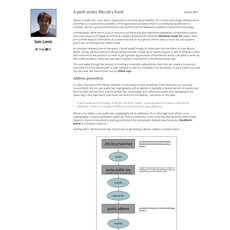Bitcoin's Academic Pedigree Review
Bitcoin's Academic Pedigree
queue.acm.org
Bitcoin's Academic Pedigree (ACM Queue) Review Guide: Everything You Need To Know + FAQ
Was Bitcoin a bolt of lightning out of nowhere, or the last puzzle piece in a decades-long project? If you’ve ever wondered, the ACM Queue article “Bitcoin’s Academic Pedigree” is a clean, credible map of what came before Satoshi hit “publish.”
I read the piece again with 2025 eyes, and here’s my plan: make the essentials crystal clear, cut the jargon fog, and translate the history into practical takeaways you can use—whether you build, invest, or you’re just trying to separate signal from hype.
“We propose a solution to the double-spending problem using a peer-to-peer network.” — Bitcoin whitepaper (2008)
Behind that one sentence sits proof-of-work, timestamping, peer-to-peer networking, and incentive design that researchers explored for decades. This guide will help you connect those dots fast and without the headache.
Why this gets confusing (and why it still matters in 2025)
Let’s be honest: the history around Bitcoin can feel like a maze.
- Is Bitcoin truly new or a remix? You’ll hear both claims—often loudly. The truth is nuanced.
- How do Hashcash, b-money, bit gold, Merkle trees, and the Byzantine Generals Problem fit together? Each solved a different piece; mixing them up leads to bad takes.
- Is a 2017 review still useful now? Yes. Foundations don’t expire. You’ll see how ideas from Chaum’s digital cash (1980s), Hashcash (1997), Byzantine fault tolerance (1982), and Merkle trees (patented 1982) set the stage—context you still need to judge modern claims.
- Jargon overload. “Probabilistic finality,” “heaviest chain,” “SPV,” “difficulty adjustment”—it’s easy to lose the plot.
The ACM piece trims the story to what actually mattered. I’ll do the same here and point you straight to the ideas that shaped Bitcoin’s design.
Here’s how I’m going to make it easy
- Break the article into plain-English chunks with real examples (e.g., how Hashcash fought spam before Bitcoin used PoW for security).
- Answer the “People Also Ask” style questions you actually Google—without fluff.
- Highlight what the authors nail, and where debates still live (like PoW costs vs. security guarantees).
- Give you a quick reading roadmap so you can scan the original efficiently and not miss the gold.
I’m keeping this practical and focused—so you finish with a clear mental model, not a list of buzzwords.
Who this is for—and what you’ll walk away with
- Students and researchers: See how research turns into systems. Trace the citation trail from proof-of-work pricing (1992) to permissionless security.
- Developers: Map concepts to real mechanics—headers, Merkle proofs, longest-chain rules, and why difficulty adjustment is the heartbeat.
- Investors and operators: Understand incentives, security budgets, and why PoW’s cost aligns with neutrality in an open network.
- Curious readers: Learn which “blockchain history” claims are legit vs. marketing copy.
Bottom line: you’ll understand the building blocks that mattered, where Satoshi actually innovated, and how to spot stories that skip the hard parts—like incentives and adversaries.
So, who wrote this ACM piece—and why should you trust their map of Bitcoin’s roots? Let’s look at that next.
What “Bitcoin’s Academic Pedigree” is, who wrote it, and why it matters
Quick overview
“Bitcoin’s Academic Pedigree” is a clear, citation-rich explainer from Arvind Narayanan and Jeremy Clark that connects Bitcoin’s design to decades of work across cryptography, distributed systems, economics, and peer‑to‑peer networking. It’s not a myth-making piece—it’s a map. You see the chain from early proof‑of‑work ideas and timestamping, through digital cash and P2P systems, to the exact ingredients Satoshi assembled in 2008.
“Bitcoin isn’t magic; it’s engineering—assembled from proven parts and incentivized to run in the wild.”
If you’ve ever felt the origin story gets hand‑wavy, this article replaces anecdotes with references you can actually check. It’s short enough for a coffee break, practical enough to sharpen how you evaluate crypto systems today.
- Cryptography: one‑way functions, digital signatures, and Merkle trees underpin secure transactions and efficient verification.
- Distributed systems: lessons from Byzantine fault tolerance explain why agreement is hard on an open network.
- Economics & incentives: making actions costly (and honest behavior profitable) steers participants toward the common ledger.
- P2P networking: gossip-style broadcast and redundancy let the system run without a central server.
Authors’ main argument
The authors argue Bitcoin is a novel synthesis, not a bolt from the blue. Its components were already on the table—Satoshi reorganized them into a system that could work at internet scale, without permission.
- Proof‑of‑Work: from pricing computation in Dwork & Naor (1992) to Hashcash (Back, 2002) against spam—Bitcoin repurposed it to secure a public ledger.
- Timestamping & hash chains: Merkle’s trees compress data into a single root, enabling efficient proofs; chained blocks enforce time‑ordering. See Merkle trees for background.
- Digital cash & privacy: Chaum’s e‑cash showed how to prevent double‑spending with a central mint (Chaum, 1983); Bitcoin removes the mint and uses PoW for coordination.
- Fault tolerance: classic BFT highlights how hard agreement is with malicious actors (Lamport et al., 1982); Bitcoin trades strict finality for probabilistic finality via the heaviest‑chain rule.
- Proto‑Bitcoin ideas: b‑money (Wei Dai) and bit gold (Nick Szabo) sketched architectures that anticipated key elements, but missed a complete incentive + difficulty + networking design.
There’s a reason the Bitcoin whitepaper directly cites Hashcash and b‑money: the lineage is real. A simple example you can picture today: Hashcash made sending email slightly costly to deter spam; Bitcoin makes producing blocks costly so attackers pay through the nose to rewrite history. Same tool, bigger stage, different outcome.
What you’ll learn from the article
This piece gives you a structured way to think about Bitcoin’s foundations—useful whether you write code, evaluate projects, or just want the real story without the fluff.
- Why proof‑of‑work existed long before Bitcoin, and how its purpose shifted from anti‑spam to ledger security.
- How Merkle trees enable light clients (SPV) to verify transactions without downloading the whole chain—think mobile wallets verifying with proofs, not trust.
- What older e‑cash systems assumed (a central mint) and why Bitcoin rejected that trust anchor.
- Why open internet consensus favors probabilistic finality over traditional BFT voting.
- How pre‑Bitcoin proposals hinted at the final recipe but didn’t yet solve incentives, difficulty adjustment, and permissionless networking together.
I like how the authors make the “new vs. borrowed” debate useful: by tracing each component to its research roots, then showing exactly what changed in 2008. It’s the difference between trivia and an actual mental model you can apply when you assess anything “blockchain” today.
Ready to see which building block solves which problem—and where the real breakthroughs happened? Up next, we’ll unpack the core ingredients one by one, starting with digital cash and privacy. Which piece would you bet was the hardest to get right?
The academic building blocks behind Bitcoin
Digital cash and privacy roots
Before anyone heard “blockchain,” there was a powerful idea: spend digital money without letting anyone clone it. David Chaum’s e-cash used blind signatures so a bank could mint coins it couldn’t trace later—a huge win for privacy. If you’ve never seen it, Chaum’s classic paper “Blind Signatures for Untraceable Payments” is still a gem (Chaum, 1983).
Chaum solved privacy and double-spend detection, but needed a trusted mint to prevent double-spends. History shows why that’s fragile: DigiCash (Chaum’s company) proved the tech worked, but when the mint is a company, it’s a single point of failure—legal, regulatory, and business risk.
Bitcoin’s twist was brutal simplicity: remove the mint entirely. Instead of a bank validating coins, a public network time-orders transactions and agrees on one canonical history. Privacy is weaker than Chaum’s system (it’s pseudonymous, not untraceable), but censorship-resistance and survivability are radically stronger.
- What carried forward: the double-spending problem, strong cryptographic primitives, and the dream of private electronic cash.
- What had to change: swap a trusted mint for an open network that can agree on “who paid whom and when” without permission.
Proof-of-Work lineage
Long before miners, Proof-of-Work (PoW) was a spam filter. Dwork and Naor (1992) proposed pricing access with small computational puzzles; Adam Back’s Hashcash turned that into a practical email header like:
X-Hashcash: 1:20:040806:[email protected]::Elj7YfZzHnU=:000A1B2C3D...
Bitcoin repurposed PoW from anti-spam to leader election and Sybil resistance for a public ledger. Instead of “prove you’re serious about sending this email,” it’s “prove you spent energy to propose this block, then earn a reward.” Two subtle but crucial pieces make it work:
- Adjustable difficulty: the network retargets roughly every 2016 blocks so blocks arrive ~every 10 minutes, regardless of total hashpower.
- Incentives: block subsidy + fees pay miners to extend the honest chain, making attacks economically uphill unless you command enormous hashpower.
Security research later mapped the game board: selfish mining can outperform naive honest mining above certain thresholds (Eyal & Sirer, 2014), and the balance between block interval, propagation, and security is delicate (Gervais et al., 2016). The key idea holds: making block production costly and predictable lets strangers coordinate on one ledger without a gatekeeper.
Timestamping and Merkle trees
If PoW is the engine, timestamping and Merkle trees are the transmission. The insight goes back to Haber–Stornetta (1991): link documents by hashing each into the next to create an immutable time-chain. Bitcoin wraps that into blocks, then stacks those blocks into a single longest chain.
Inside each block, transactions are hashed pairwise until a single Merkle root remains (see Merkle, 1989/1990s). That root goes in the 80-byte block header. Why it matters:
- Compression: thousands of transactions summarized in 32 bytes.
- Efficient verification: light clients use SPV proofs—just a handful of hashes along the Merkle path—to verify inclusion without storing the whole block.
- Time-ordering: chaining headers locks in order; reversing it means redoing work on every block after.
As Satoshi put it in the whitepaper:
“The longest chain not only serves as proof of the sequence of events witnessed, but proof that it came from the largest pool of CPU power.”
Byzantine fault tolerance and networking
Distributed systems had wrestled with “how do we agree if some nodes lie?” since the Byzantine Generals Problem (Lamport et al., 1982). Systems like PBFT (Castro & Liskov, 1999) could reach fast finality, but only with known members and small networks.
Bitcoin side-steps strict voting. Instead, it uses:
- Open membership: anyone can join with a node; PoW throttles Sybils.
- Probabilistic finality: more confirmations mean exponentially lower reorg risk.
- Longest-chain (heaviest-work) rule: a simple, local rule every node can apply, even if the internet is messy and asynchronous.
That trade—permissionless robustness over instant finality—lets Bitcoin scale across the public internet with no coordinator. In practice, gossip-based propagation and compact headers keep bandwidth manageable while the chain marches forward.
Pre-Bitcoin proposals that set the stage
Two proposals read like early blueprints:
- b-money (Wei Dai, 1998): described a broadcast ledger, PoW-based money creation, and contract enforcement. What it missed: a concrete, working consensus mechanism that handles double-spends robustly in an open setting.
- bit gold (Nick Szabo, 2005): proposed chained PoW “chunks” with property uniqueness and timestamping markets. What it lacked: a unified, global state with simple rules to resolve conflicts among independent “mints.”
Bitcoin stitched the missing parts: a universal chain, automatic difficulty adjustment, and incentives that push rational participants to extend, not rewrite, history.
Incentives and game theory
Money isn’t secured by math alone; it’s secured by motives. Mining rewards set a security budget—the cost to overpower the chain rises with the hashpower competing for rewards. That’s why the block subsidy and fees matter, and why timing and propagation impact attack costs. Work by Carlsten et al. (2016) warned that a fee-only future could change incentives; Bitcoin’s fee dynamics and layer-2 usage continue to evolve around that reality.
At a human level, this is what clicked for me the first time I sent a small on-chain payment and watched confirmations roll in: thousands of strangers, each chasing their own reward, accidentally cooperate to protect my transaction. That’s the quiet genius—simple rules that make the honest path the most profitable path.
Curious how all these parts add up to “Is Bitcoin truly original or mostly borrowed?” and “What problem does Proof-of-Work actually solve?” I’ll tackle those head-on next—and some answers might surprise you.
Answering the big “People also ask” questions
Is Bitcoin truly original or mostly borrowed?
I get this one a lot. The honest answer: both. The ingredients—proof-of-work, hash chains, timestamping, e-cash, P2P networking—were on the shelf. The leap was assembling them into an open, incentive-driven system that anyone can join without permission.
- Combination breakthrough: open proof-of-work chain + miner incentives + automatic difficulty adjustment + SPV (simplified payment verification).
- Result: a permissionless ledger where economic pressure keeps consensus honest, not a central operator.
In practice, that’s like taking known gears and springs and inventing the first working wristwatch. The parts weren’t new; the engineering was.
“The longest chain not only serves as proof of the sequence of events witnessed, but proof that it came from the largest pool of CPU power.” — Bitcoin whitepaper
Who influenced Satoshi the most?
When I read the Bitcoin whitepaper citations, a few names keep popping up:
- Adam Back’s Hashcash — turned computation into a cost to stop spam. Bitcoin reuses that as the backbone of security. Source: Hashcash paper.
- Wei Dai’s b-money — laid out a ledger idea with community enforcement and PoW elements. It foreshadows miners as accountants. Summary: b-money proposal.
- Nick Szabo’s bit gold — introduced the idea of chained PoW tokens with market value. Outline: bit gold essay.
- Ralph Merkle — Merkle trees make light verification (SPV) possible. Primer: Merkle tree.
- Haber & Stornetta — digital timestamping and hash chains from the ‘90s. Paper: How to Time-Stamp a Digital Document (1991).
These weren’t “almost Bitcoin,” but they were the skeleton. Satoshi added the muscle: incentives, global P2P propagation, and a working security budget.
What problem does Proof-of-Work solve in Bitcoin?
It forces skin in the game. Publishing blocks is costly, so honest behavior becomes the best strategy unless an attacker controls massive hashpower.
- Cost to write history: PoW makes rewriting the ledger economically brutal. See the attack probability math in the whitepaper’s Appendix: Section 11.
- Order and finality: blocks arrive probabilistically; the chain with the most cumulative work wins, not the one with the loudest votes.
- Aligned incentives: miners earn block rewards/fees only if they extend the honest chain.
Empirical support: research shows network propagation and orphan rates keep honest miners coordinated while raising the bar for attackers. See Decker & Wattenhofer (2013) on propagation dynamics and stale blocks, and Gervais et al. (2016) on security vs. confirmation depth: paper, arXiv.
How does Bitcoin stop double-spending without a bank?
By turning the ledger into a public competition where the heaviest valid chain is the truth everyone accepts.
- Chain selection: nodes validate blocks and pick the chain with the most accumulated work.
- Conflict handling: if two transactions spend the same coin, only the one in the longest valid chain survives. The other is rejected.
- SPV safety: light clients don’t need every transaction; they verify headers/merkle proofs and rely on the honest majority assumption.
In the real world, this is why merchants ask for confirmations. The cost of reversing grows with each block—fast.
What is the Byzantine Generals Problem here?
It’s the classic “how do we agree if some players are faulty or malicious?” In Bitcoin, the answer isn’t a voting round. It’s economics.
- No global vote: instead of counting people or nodes, Bitcoin counts work.
- Probabilistic finality: deeper blocks are exponentially harder to revert, approaching near-certainty.
- Attack thresholds matter: selfish mining research (Eyal & Sirer, 2014) suggests advantages emerge around 25–33% hashpower, which influenced pool/relay design and fee policy debates. Source: paper.
Short version: Byzantine tolerance via paid participation. Cheating gets expensive; honest mining stays profitable.
Are blockchains older than Bitcoin?
The core pieces are older. The name and the permissionless, incentive-secured recipe are what Bitcoin popularized.
- Hash-linked structures: known since the 1970s–1990s (Merkle, Haber & Stornetta).
- Public timestamping: Surety anchored hashes in the New York Times classifieds in the ‘90s. Evidence: Surety’s archive.
- What’s new in Bitcoin: open participation + PoW + incentives + difficulty adjustment + SPV.
So yes, the “chain of blocks” is older—Bitcoin is where it became money-grade.
Is the 2017 ACM article still relevant now?
Absolutely for understanding the roots. The foundations haven’t changed, even though the landscape has.
- Still timeless: proof-of-work lineage, timestamping, Merkle trees, P2P networking, incentive design.
- What it won’t cover: ordinals, modern mining markets, rollups, or today’s fee dynamics.
- Why read it in 2025: it gives you the mental model to judge new trends without falling for buzzwords. Pair it with a modern textbook like Bitcoin and Cryptocurrency Technologies for extra depth.
If you’ve ever felt the “is this innovation or rebranding?” anxiety, this piece calms the noise and shows the real lineage.
Quick gut-check: Which idea solves which problem—costly publishing, ordering, double-spend prevention, or light verification? If that’s fuzzy, you’ll love what’s next. Want a skim-to-win plan that saves you 30 minutes and points you to the exact sections and citations to mark?
How to read the ACM piece efficiently (and what to look for)
Skim-to-win plan
Open the article here: Bitcoin’s Academic Pedigree (ACM Queue). Give yourself 20 minutes for a smart skim, then 40 minutes for a targeted reread with notes.
My approach:
- Start with the backbone: proof-of-work, timestamping/chain ordering, and the pre-Bitcoin proposals. These are the pillars of the argument.
- CTRL+F your way through: search for “proof-of-work,” “Hashcash,” “Merkle,” “b-money,” “bit gold,” “Byzantine,” and “SPV.” You’ll jump to the critical passages instantly.
- Note map (simple 3-column table in your notes app):Problem → Prior Idea → Bitcoin Feature
- Spam/Sybil costs → Hashcash (Back, 2002) → Mining PoW with difficulty
- Global ordering → Timestamping + hash chains (Merkle) → Chained blocks
- No central mint → Incentives + openness → Block rewards + fees
- Light verification → Merkle proofs → SPV nodes
- Highlight the citations: when the authors reference Dwork–Naor (1992), Back (2002), Dai (b-money), Szabo (bit gold), and BFT research, mark them as “solved X.” This prevents you from over-crediting any single ancestor.
- Translate to headers: whenever you read “ordering” or “proof,” think of the block header fields: version | prev_block_hash | merkle_root | time | nBits | nonce. This is where the academic ideas show up as engineering reality.
Pro tip: Treat every cited paper as solving a specific bottleneck. If you can’t state “what bottleneck it solved” in one line, re-read that part.
Reading goals by persona
- Developers:
- Map concepts to Bitcoin Core mechanics. When you see “difficulty adjustment,” think GetNextWorkRequired and the nBits field. When you see “Merkle trees,” think merkleblock, tx inclusion proofs, and headers-first sync.
- Actionable checks:
- Grab a block header (any explorer will show you) and compute the target from nBits. That’s the article’s PoW cost in math form.
- Verify a Merkle proof for a transaction. That’s SPV in your hands, exactly what the article points to as a practical outcome of Merkle’s idea.
- Keep in mind why Bitcoin chooses probabilistic finality over classical BFT. It scales to open networks without identity assumptions.
- Investors:
- Zero in on incentives, the security budget (issuance + fees), and why PoW creates credible neutrality. The piece makes clear: cost to attack grows with hashrate and honest participation.
- Cross-check the claims with known results: selfish mining risk (Eyal & Sirer, 2014), economic limits (Budish, 2018), and the “backbone” model for PoW safety (Garay et al., 2015). These studies align with the article’s thesis that incentives, not committees, hold the system together.
- Reading lens: ask “What pays for security here?” and “What stops cheap identity attacks?” If the answer isn’t economic, it’s not Bitcoin’s model.
- Students:
- Create a timeline in your notes: Dwork–Naor (1992) → Hashcash (2002) → b-money (1998) → bit gold (mid-2000s) → Satoshi (2008).
- For each entry, write a one-sentence contribution:
- Dwork–Naor: making computation a cost to limit abuse.
- Hashcash: practical PoW for spam resistance.
- b-money: outline of a money system with PoW and communal accounting.
- bit gold: chained PoW puzzles as proto-ledger.
- Bitcoin: open network + incentive-aligned PoW chain + difficulty + SPV.
- Build a concept map. Connect Merkle trees to SPV, PoW to Sybil resistance, and longest-chain to probabilistic consensus. If a link feels fuzzy, that’s your re-read target.
Key takeaways to watch for
- The big shift: from centralized e-cash to permissionless money. The article shows how removing the mint required replacing identity and trust with economics and computation.
- Incentives are security: cost to mine vs. payoff to attack is the heart of safety. This isn’t window dressing—it’s the core design principle.
- Assembly is the innovation: the ideas existed, but Bitcoin’s assembly—open PoW chain, difficulty adjustment, miner incentives, and SPV—is what made it work in the wild.
- Finality is probabilistic: confirmations reduce risk mathematically. This is a feature, not a bug, for global, permissionless settings.
Common pitfalls to avoid
- Mixing up Hashcash and Bitcoin’s PoW: Hashcash fought email spam; Bitcoin repurposes PoW to secure a global ledger and coordinate consensus. Same tool, different game.
- Over-crediting a single ancestor: b-money and bit gold are crucial previews, but without difficulty adjustment, incentives, and SPV, you don’t get a robust, open system.
- Thinking “blockchain” alone solves trust: a hash chain without incentives is just a log. The article makes clear: economics are inseparable from the tech.
- Forgetting forks and reorgs are normal: temporary disagreement is expected. The longest valid chain rule resolves it as honest work accumulates.
- Confusing BFT voting with Bitcoin’s model: classic BFT assumes known parties; Bitcoin assumes anyone can join, so it uses cost (PoW) and probability, not identity and quorum votes.
Want the one-sentence summary, quick FAQ, and my verdict before you head to the next rabbit hole? That’s coming up next—curious which ancestor actually mattered most once the rubber met the road?
FAQ and final verdict
What’s the one-sentence summary?
Bitcoin stands on decades of research, and this ACM article is your clean map of the roots behind its cryptography, networking, and incentive design.
Quick FAQ hits
- Who wrote it? Arvind Narayanan and Jeremy Clark. Read it here: Bitcoin’s Academic Pedigree (ACM Queue).
- What are the main ancestors? Hashcash (proof-of-work for spam), Merkle trees and timestamping, proposals like Hashcash, b-money, and bit gold, plus peer-to-peer systems and Byzantine fault tolerance research.
- Is PoW wasteful by design? It’s intentionally costly so publishing blocks has real economic weight. That cost anchors the ledger’s neutrality, because anyone can compete to add blocks without permission. If you want numbers, the Cambridge Bitcoin Electricity Consumption Index tracks consumption and emissions estimates; methods and conclusions vary across studies, but the security rationale is consistent: cost discourages cheap attacks.
- Is Bitcoin still unique? Yes. A permissionless network with open entry to consensus, externalized security via PoW, global difficulty adjustment, and SPV compatibility is a very specific combo. You can see the difference in practice when a mobile wallet verifies payments with header chains and Merkle proofs without trusting a server—hard to replicate in many other systems.
- Do I need to read the original? If you care about crypto beyond headlines, yes. It’s short, clearly written, and links directly to the papers that shaped Bitcoin. Bookmark it and revisit as you learn.
What I liked (and what’s missing)
What worked for me: tight history, accurate citations, and crisp connections from research to real features. It shows how proof-of-work stopped being just anti-spam and became the backbone of an open monetary network, and how Merkle trees make light-client verification practical. The authors never oversell one ancestor as “the” source; they show the assembly.
What it doesn’t cover (fairly, given the date):
- Post-2017 scaling and usage shifts: Taproot upgrades, the growth of the Lightning Network, and fee dynamics during high-demand windows (think inscriptions-driven spikes in late 2023 and spring 2024) changed how we talk about throughput and incentives.
- Mining market structure: Industrial miners, grid-curtailment deals, and the emergence of hashprice markets added new wrinkles to incentives. For energy data, I usually start with Cambridge’s CBECI and then compare independent analyses; expect disagreement, but you’ll get a baseline.
- Modern threat modeling and fees: The fee-based security debate matured with live tests in 2023–2024. When blocks filled and fees spiked, orphan rates, mempool policy, and miner behavior gave us real-world data that earlier theory could only predict.
Tip: If you’ve never tried it, send a tiny payment to a mobile wallet and watch it verify using just headers and a Merkle proof. That’s the paper-to-product moment the article prepares you for.
My verdict
If you’ve ever asked, “Where did Bitcoin really come from?” this is the clearest short answer I point people to. It’s not a museum tour—it’s a blueprint. Read the ACM piece, keep a note on which idea solves which problem, and you’ll walk away with a sharper mental model of Bitcoin’s design. That clarity pays off whether you’re building, investing, or just trying to separate signal from noise.
Next steps:
- Read the article: Bitcoin’s Academic Pedigree.
- Skim the originals: Hashcash, b-money, bit gold, and Merkle’s tree paper summaries.
- Then watch it work: use a wallet that supports SPV and compare what it verifies locally vs. what it fetches from peers.
Short version: read it, bookmark it, and keep building your own map. The history isn’t trivia—it’s the why behind what still runs Bitcoin today.













